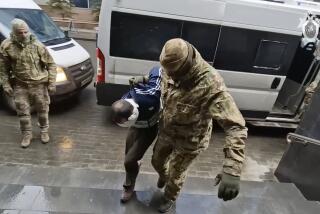Lethal Clashes in Uzbekistan Sow Fear for the Fates of the Missing
- Share via
ANDIJON, Uzbekistan — Sanjab Valiakhunov’s family can’t find him, no matter how hard they search.
“In the last three days I was everywhere. I was at the morgue, at the hospital. He’s not there,” his sister, Rakhat Valiakhunova, said Thursday in despair after clashes here last week left at least 169 people dead by official count, and hundreds more according to human rights activists and others.
“They didn’t let me into the morgue, though,” she added. “They just said, ‘Your brother is not here,’ as if they know my brother. Or maybe they just don’t have any bodies in the morgue and don’t want to admit it.
“I know that many families have been going around town looking for their loved ones and can’t find them.”
This brutalized eastern Uzbek town continued to mourn its dead and missing as officials sought to bring back a semblance of normality. Dozens of roadblocks had been taken down. Seven armored personnel carriers maintained a commanding presence on major streets, but vehicle and pedestrian traffic had resumed, even in the city center.
There were other signs that the government of President Islam Karimov, Uzbekistan’s Communist boss before the 1991 collapse of the Soviet Union and authoritarian ruler of the country ever since, had reestablished at least short-term control in this tense region.
Government authorities reappeared Thursday in the Uzbek-Kyrgyz border town of Korasuv, which they had fled after rioters burned buildings there Saturday.
BBC television and Associated Press reported the arrest of a farmer turned Islamic leader, Bakhtiyor Rakhimov, who a day earlier told journalists that residents had taken control of the town and would use it as a base to build an Islamic state.
Rakhimov’s home was raided before dawn by 30 special forces troops, who took him and his 14-year-old son away, AP reported, quoting his wife.
In Andijon, Mutabarkhon Valiakhunova, 65, sat on a sofa in a room adorned with rugs and dark red wallpaper, crying in fear for her son.
“I hope he’s hiding someplace,” she said. “You know how they can arrest anyone now.”
Neither mother nor sister said they had any reason to believe that Valiakhunov participated in the clashes here, which ended with a bloody crackdown on protesters and armed militants by government troops. But they feared that he was caught up in the chaos somehow.
Militants stormed a prison before dawn May 13 to release inmates, including 23 local businessmen who were on trial for alleged Islamic extremism. Gunmen then seized a government building in central Andijon, and a large protest rally followed in a city square.
When troops arrived and began firing, groups of people moved in several directions, and shootings occurred in several locations, said journalists at the scene and witnesses who spoke with Western media, including the Los Angeles Times.
Valiakhunova said her 27-year-old son, who works in a sweets factory, was not an Islamic extremist.
“Yes, he was religious, but he went to the mosque very seldom,” she said. “I don’t believe he was [at the protest]. I don’t want to find his body. It’s better that he’s missing.”
The sister, breaking into tears, exclaimed, “It’s all about religion!”
“Islam is a good religion,” she said. “Why can’t it be professed properly here like in many other countries? Why do people have to die and disappear?”
Karimov’s secular government keeps a tight rein on mosques, yet underground groups that mix rigorous religious values with radical political goals have grown.
The government characterizes the arrest of thousands of suspected Islamic radicals in recent years, such as the 23 businessmen detained in Andijon, as part of a battle against terrorism and an effort to preserve Uzbekistan’s secular society.
But human rights organizations have warned that the repression might trigger a violent backlash.
That appeared to be at least part of the explanation for the events of last week.
Murad Usmanov, 28, an unemployed man who lives near the center of town, said he witnessed a clash during the evening in which many people died.
“I can’t say that the demonstration was peaceful,” he said. “At first, it seemed to me that the huge crowd of at least several hundred people mostly consisted of 16- and 17-year-olds. But then I looked at them more closely and saw there were women and children among them, and also men armed with Kalashnikovs. They were marching along the street chanting, ‘Freedom.’ ”
Some in the crowd fired “a few shots at the security building,” Usmanov said. “They proceeded to the end of the street, where they were mowed down by the large-caliber machine gun on an armored personnel carrier,” or APC.
“I counted at least three trucks filled with bodies.”
He also watched the soldiers collect more than 100 Kalashnikov automatic rifles that had been carried by people in the crowd, he said.
“Eyewitnesses say that the bodies were barely taken out of town and were thrown into a pit at the site of a dump in Bustam Street, and that tractors covered the bodies with earth,” Usmanov said.
“Now there is an APC parked at that location at all times, and people are afraid to approach it. At least two of my friends went missing after that night.”
One of them, he said, was Sanjab Valiakhunov.
Holley reported from Moscow and Loiko from Andijon.
More to Read
Sign up for Essential California
The most important California stories and recommendations in your inbox every morning.
You may occasionally receive promotional content from the Los Angeles Times.













